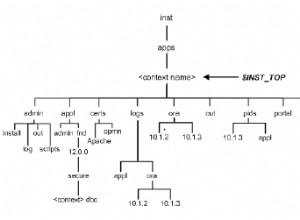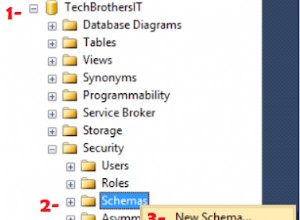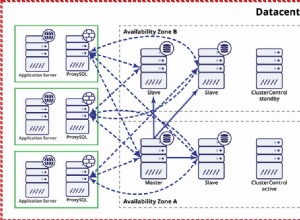Comenzando con la sintaxis de procedimientos almacenados en MySQL (usando la terminal):
[email protected]:~$ mysql -u root -p
Enter password:
Welcome to the MySQL monitor. Commands end with ; or \g.
mysql>
mysql> show procedure status;
+-----------+---------------+-----------+---------+---------------------+---------------------+---------------+---------+----------------------+----------------------+--------------------+
| Db | Name | Type | Definer | Modified | Created | Security_type | Comment | character_set_client | collation_connection | Database Collation |
+-----------+---------------+-----------+---------+---------------------+---------------------+---------------+---------+----------------------+----------------------+--------------------+
| yourdb | sp_user_login | PROCEDURE | [email protected]% | 2013-12-06 14:10:25 | 2013-12-06 14:10:25 | DEFINER | | utf8 | utf8_general_ci | latin1_swedish_ci |
+-----------+---------------+-----------+---------+---------------------+---------------------+---------------+---------+----------------------+----------------------+--------------------+
1 row in set (0.01 sec)
Tengo uno definido, probablemente no tengas ninguno para empezar.
mysql> use yourdb;
Database changed
mysql> drop procedure if exists sp_user_login;
Query OK, 0 rows affected (0.01 sec)
mysql> show procedure status;
Empty set (0.00 sec)
mysql> delimiter //
mysql> create procedure foobar()
-> begin select 'hello'; end//
Query OK, 0 rows affected (0.00 sec)
// se comunicará con el terminal cuando haya terminado de ingresar comandos para el procedimiento almacenado. el nombre del procedimiento almacenado es foobar. no toma parámetros y debe devolver "hola".
mysql> show procedure status;
->
->
¡Entendido! ¿Por qué no funcionó esto? Estableces el delimitador en // ¿recordar? Establézcalo de nuevo en ;
mysql> delimiter ;
mysql> show procedure status;
+-----------+--------+-----------+----------------+---------------------+---------------------+---------------+---------+----------------------+----------------------+--------------------+
| Db | Name | Type | Definer | Modified | Created | Security_type | Comment | character_set_client | collation_connection | Database Collation |
+-----------+--------+-----------+----------------+---------------------+---------------------+---------------+---------+----------------------+----------------------+--------------------+
| yourdb | foobar | PROCEDURE | [email protected] | 2013-12-06 14:27:23 | 2013-12-06 14:27:23 | DEFINER | | utf8 | utf8_general_ci | latin1_swedish_ci |
+-----------+--------+-----------+----------------+---------------------+---------------------+---------------+---------+----------------------+----------------------+--------------------+
1 row in set (0.00 sec)
mysql> call foobar();
+-------+
| hello |
+-------+
| hello |
+-------+
1 row in set (0.00 sec)
Query OK, 0 rows affected (0.00 sec)
Hola mundo completo, sobreescribámoslo con algo mejor.
mysql> drop procedure foobar;
Query OK, 0 rows affected (0.00 sec)
mysql> show procedure status;
Empty set (0.00 sec)
mysql> delimiter //
mysql> create procedure foobar (in var1 int)
-> begin select var1 + 2 as result;
-> end//
Query OK, 0 rows affected (0.00 sec)
mysql> delimiter ;
mysql> call foobar(5);
+--------+
| result |
+--------+
| 7 |
+--------+
1 row in set (0.00 sec)
Query OK, 0 rows affected (0.00 sec)
¡Lindo! Hicimos un procedimiento que toma entrada, la modifica y da salida. Ahora hagamos una variable de salida.
mysql> delimiter ;
mysql> drop procedure foobar;
Query OK, 0 rows affected (0.00 sec)
mysql> delimiter //
mysql> create procedure foobar(out var1 varchar(100))
-> begin set var1="kowalski, what's the status of the nuclear reactor?";
-> end//
Query OK, 0 rows affected (0.00 sec)
mysql> delimiter ;
mysql> call foobar(@kowalski_status);
Query OK, 0 rows affected (0.00 sec)
mysql> select @kowalski_status;
+-----------------------------------------------------+
| @kowalski_status |
+-----------------------------------------------------+
| kowalski, what's the status of the nuclear reactor? |
+-----------------------------------------------------+
1 row in set (0.00 sec)
mysql> select 'ricksays' into @msg;
Query OK, 1 row affected (0.00 sec)
mysql> delimiter //
mysql> create procedure foobar (inout msg varchar(100))
-> begin
-> set msg = concat(@msg, " never gonna let you down");
-> end//
mysql> delimiter ;
mysql> call foobar(@msg);
Query OK, 0 rows affected (0.00 sec)
mysql> select @msg;
+-----------------------------------+
| @msg |
+-----------------------------------+
| ricksays never gonna let you down |
+-----------------------------------+
1 row in set (0.00 sec)
Ok, funcionó, unió las cuerdas. Así que definió una variable msg, pasó esa variable a un procedimiento almacenado llamado foobar, y foobar escribió @msg.
Ahora ya sabes cómo hacer procedimientos almacenados con delimitadores. Continúe este tutorial aquí, comience con las variables dentro de los procedimientos almacenados:http ://net.tutsplus.com/tutorials/una-introducción-a-los-procedimientos-almacenados/




